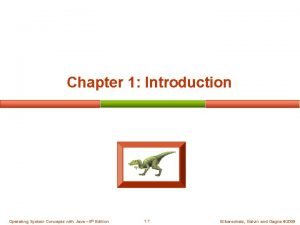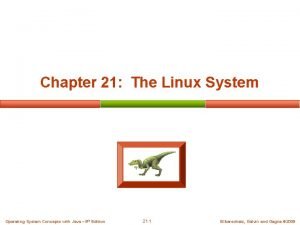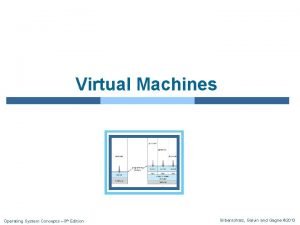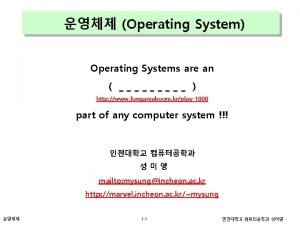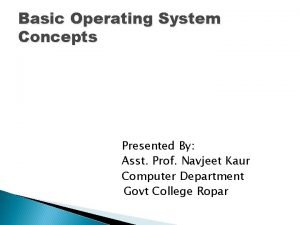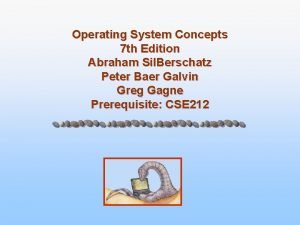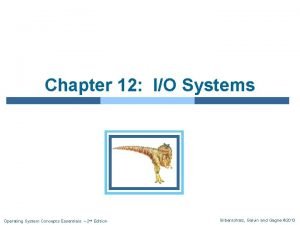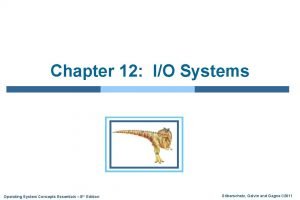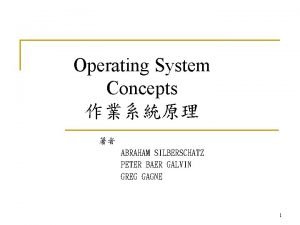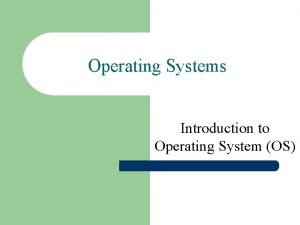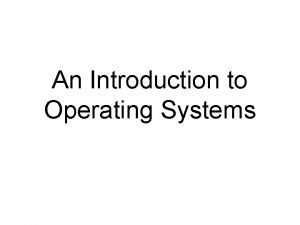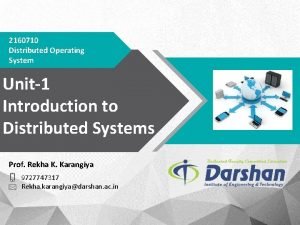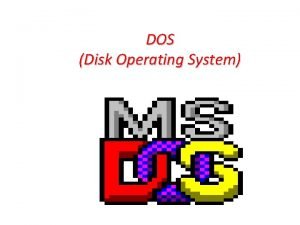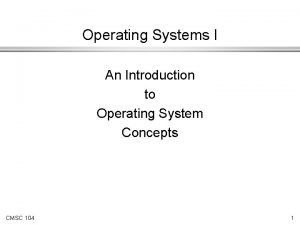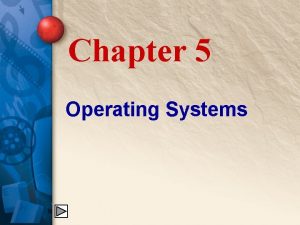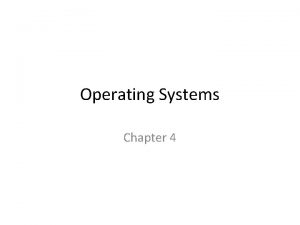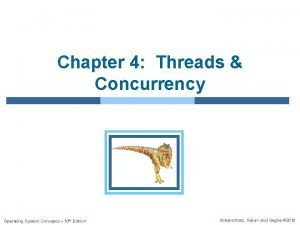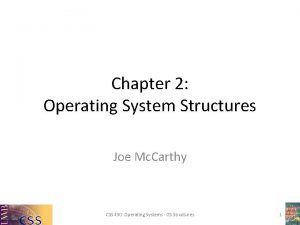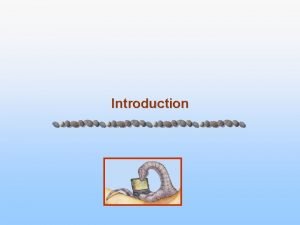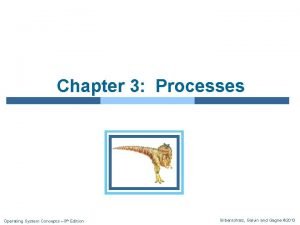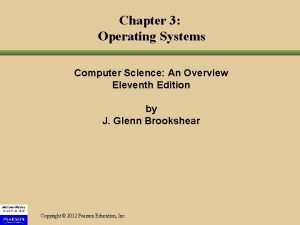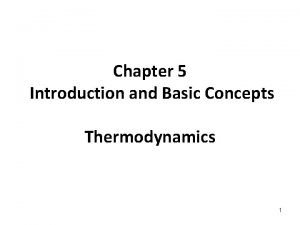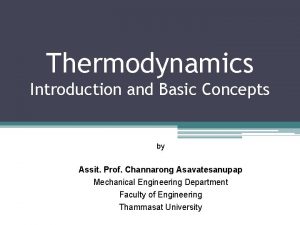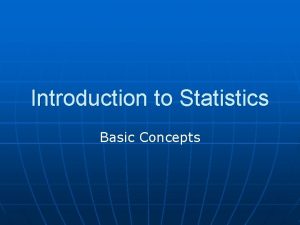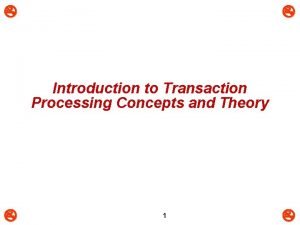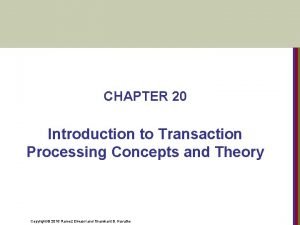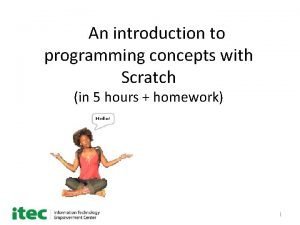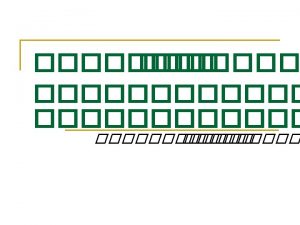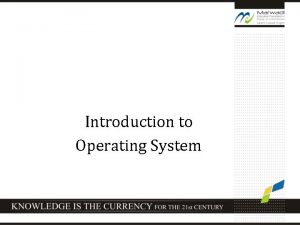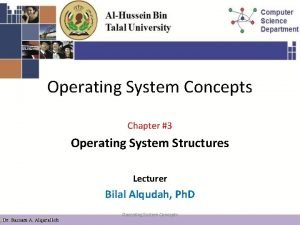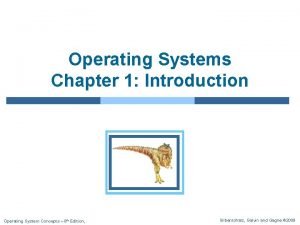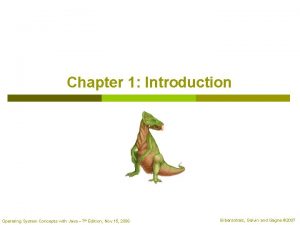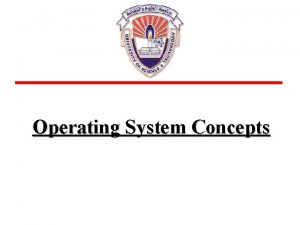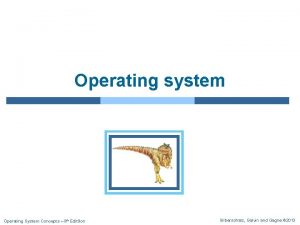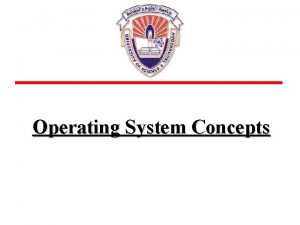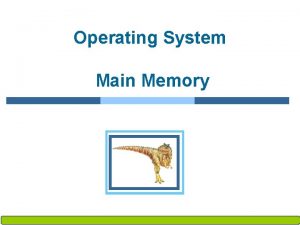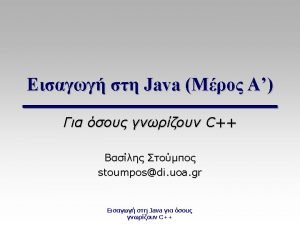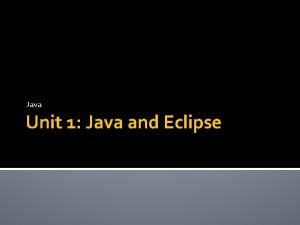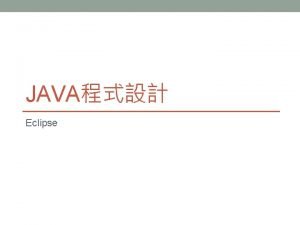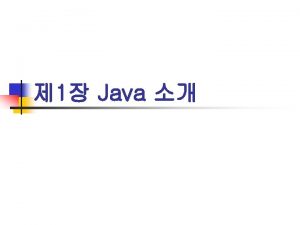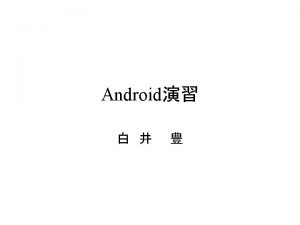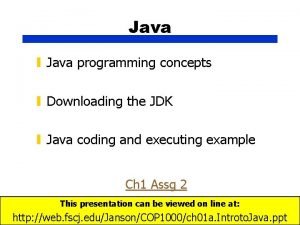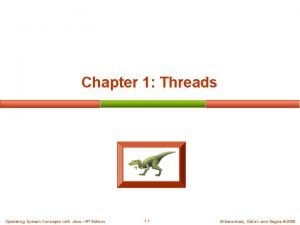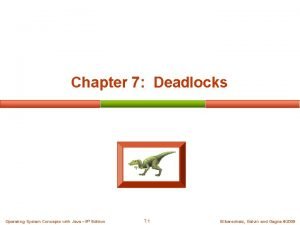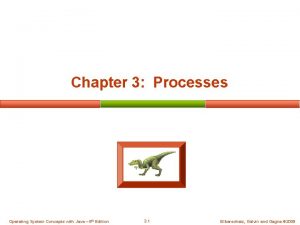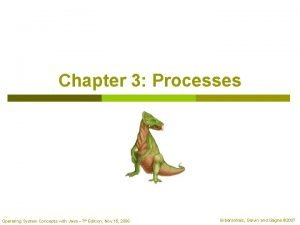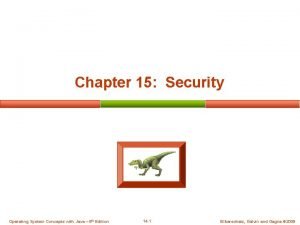Chapter 1 Introduction Operating System Concepts with Java















































- Slides: 47

Chapter 1: Introduction Operating System Concepts with Java – 8 th Edition 1. 1 Silberschatz, Galvin and Gagne © 2009

Chapter 1: Introduction n What Operating Systems Do n Computer-System Organization n Computer-System Architecture n Operating-System Structure n Operating-System Operations n Process Management n Memory Management n Storage Management n Protection and Security Operating System Concepts with Java – 8 th Edition 1. 2 Silberschatz, Galvin and Gagne © 2009

Objectives n To provide a grand tour of the major operating systems components n To provide coverage of basic computer system organization Operating System Concepts with Java – 8 th Edition 1. 3 Silberschatz, Galvin and Gagne © 2009

What is an Operating System? n A program that acts as an intermediary between a user of a computer and the computer hardware n Operating system goals: l Execute user programs and make solving user problems easier l Make the computer system convenient to use l Use the computer hardware in an efficient manner Operating System Concepts with Java – 8 th Edition 1. 4 Silberschatz, Galvin and Gagne © 2009

Computer System Structure n Computer system can be divided into four components Hardware – provides basic computing resources 4 CPU, memory, I/O devices l Operating system 4 Controls and coordinates use of hardware among various applications and users l Application programs – define the ways in which the system resources are used to solve the computing problems of the users 4 Word processors, compilers, web browsers, database systems, video games l Users 4 People, machines, other computers l Operating System Concepts with Java – 8 th Edition 1. 5 Silberschatz, Galvin and Gagne © 2009

Four Components of a Computer System Operating System Concepts with Java – 8 th Edition 1. 6 Silberschatz, Galvin and Gagne © 2009

Operating System Definition n OS is a resource allocator l Manages all resources l Decides between conflicting requests for efficient and fair resource use n OS is a control program l Controls execution of programs to prevent errors and improper use of the computer Operating System Concepts with Java – 8 th Edition 1. 7 Silberschatz, Galvin and Gagne © 2009

Operating System Definition (Cont) n No universally accepted definition n “Everything a vendor ships when you order an operating system” is good approximation l But varies wildly n “The one program running at all times on the computer” is the kernel. Everything else is either a system program (ships with the operating system) or an application program. Operating System Concepts with Java – 8 th Edition 1. 8 Silberschatz, Galvin and Gagne © 2009

Computer Startup n bootstrap program is loaded at power-up or reboot l Typically stored in ROM or Erasble Programmable (ROM), generally known as firmware l Initializes all aspects of system such as CPU registers, device controllers, and memory contents. l Loads operating system kernel and starts execution Operating System Concepts with Java – 8 th Edition 1. 9 Silberschatz, Galvin and Gagne © 2009

1. 2 Computer System Organization n Computer-system operation l One or more CPUs, device controllers connect through common bus providing access to shared memory l Concurrent execution of CPUs and devices competing for memory cycles Operating System Concepts with Java – 8 th Edition 1. 10 Silberschatz, Galvin and Gagne © 2009

1. 2. 1 Computer-System Operation n I/O devices and the CPU can execute concurrently n Each device controller is in charge of a particular device type, and has a local buffer n CPU moves data from/to main memory to/from local buffers n I/O is from the device to local buffer of controller n Device controller informs CPU that it has finished its operation by causing an interrupt Operating System Concepts with Java – 8 th Edition 1. 11 Silberschatz, Galvin and Gagne © 2009

Common Functions of Interrupts n The occurrence of an event is usually triggered by an interrupt. n Hardware may trigger an interrupt at any time by sending a signal to the CPU. n Software may trigger an interrupt by executing a system call. n Interrupt transfers control to the interrupt service routine generally, through the interrupt vector, which contains the addresses of all the service routines. n When the interrupt service routine completes, the CPU resumes the interrupted computation. n The operating system preserves the state of the CPU by storing registers and the program counter Operating System Concepts with Java – 8 th Edition 1. 12 Silberschatz, Galvin and Gagne © 2009

Common Functions of Interrupts n Interrupt architecture must save the address of the interrupted instruction. n Incoming interrupts are disabled while another interrupt is being processed to prevent a lost interrupt n A trap is a software-generated interrupt caused either by an error or a user request n An operating system is interrupt driven Operating System Concepts with Java – 8 th Edition 1. 13 Silberschatz, Galvin and Gagne © 2009

1. 2. 2 Storage Structure n Main memory – ONLY large storage media that the CPU can access directly, so any program must be stored there. l Also called Random-access memory (RAM). n Secondary storage – extension of main memory that provides large nonvolatile storage capacity n Magnetic disks – rigid metal or glass platters covered with magnetic recording material l Disk surface is logically divided into tracks, which are subdivided into sectors l The disk controller determines the logical interaction between the device and the computer Operating System Concepts with Java – 8 th Edition 1. 14 Silberschatz, Galvin and Gagne © 2009

Storage-Device Hierarchy n Storage systems organized in hierarchy l Speed l Cost l Volatility Either n Caching – copying information into faster storage system; main memory can be viewed as a last cache for secondary storage Operating System Concepts with Java – 8 th Edition 1. 15 Silberschatz, Galvin and Gagne © 2009

Caching n Important principle, performed at many levels in a computer (in hardware, operating system, software) n Information in use copied from slower to faster storage temporarily n Faster storage (cache) checked first to determine if information is there l If it is, information used directly from the cache (fast) l If not, data copied to cache and used there n Cache smaller than storage being cached l Cache management important design problem l Cache size and replacement policy Operating System Concepts with Java – 8 th Edition 1. 16 Silberschatz, Galvin and Gagne © 2009

1. 2. 3 I/O Structure n A general-purpose computer system consists of CPUs and multiple device controllers that are connected through a common bus. n Device controller is (part of device) in charge of a specific type of device, l has local buffer and register, l moves data from device to local buffer, and l informs device driver when data transfer is complete. l n Device driver (part of OS) understands the device controller and presents a uniform interface to the device to the rest of the OS. Operating System Concepts with Java – 8 th Edition 1. 17 Silberschatz, Galvin and Gagne © 2009

How a Modern Computer Works 1. Device driver loads controller register with instruction 2. Controller examines register content. 3. Controller transfer data from device to its local buffer. 4. Controller informs device driver with an interrupt. 5. Driver returns control to OS. Interplay of all components of a computer system. Operating System Concepts with Java – 8 th Edition 1. 18 Silberschatz, Galvin and Gagne © 2009

Direct Memory Access Structure 1. Device driver loads controller register with instruction 2. Controller examines register content. 3. Controller transfer data from device to its local buffer. 4. Controller informs device driver with an interrupt. 5. Driver returns control to OS. 4’. Device controller transfers blocks of data from buffer directly to memory without CPU intervention 5. Only one interrupt is generated per block, rather than the one interrupt per byte Operating System Concepts with Java – 8 th Edition 1. 19 Used for high-speed I/O devices able to transmit information at close to memory speeds. Silberschatz, Galvin and Gagne © 2009

1. 3 Computer-System Architecture n Most systems use a single general-purpose processor (PDAs through mainframes) l Most systems have special-purpose processors as well l Such as a disk-controller has a microprocessor it implement its own disk queue and scheduling algorithm. This relieves the overhead of main CPU. l Keyboard contains a microprocessor to convert the keystrokes into codes to be sent to CPU. n There is only one general purpose CPU. Operating System Concepts with Java – 8 th Edition 1. 20 Silberschatz, Galvin and Gagne © 2009

1. 3. 2 Multiprocessor System n Multiprocessors systems growing in use and importance l Also known as parallel systems, tightly-coupled systems l Such systems have two or more processors in close communication, sharing the computer bus, and sometimes the clock and memory. l Advantages include 1. Increased throughput 2. Economy of scale 3. Increased reliability – graceful degradation or fault tolerance Operating System Concepts with Java – 8 th Edition 1. 21 Silberschatz, Galvin and Gagne © 2009

1. 3. 2 Multiprocessor System • Asymmetric multiprocessing – maintain a master-slave relationship. The master processor schedules and allocates work to the slave processors. • Symmetric multiprocessing (SMP) – each processor has its own set of registers, as well as local cache. All processors share physical memory. Symmetric multiprocessing architecture Operating System Concepts with Java – 8 th Edition 1. 22 Silberschatz, Galvin and Gagne © 2009

A Dual-Core Design • Include multiple computing cores on a single chip. • More efficient than multiple chips with single cores because on-chip communication is faster than b/w chip communicate. • One chip with multiple cores uses less power. Operating System Concepts with Java – 8 th Edition 1. 23 Silberschatz, Galvin and Gagne © 2009

1. 3. 3 Clustered Systems n Clustered computers share storage and closely linked via a local- area network (LAN). n Like multiprocessor systems, but multiple systems working together l Provides a high-availability service which survives failures 4 Asymmetric clustering has one machine in hot-standby mode which monitors and backups servers. 4 Symmetric clustering has multiple nodes running applications, monitoring each other l Some clusters are for high-performance computing (HPC) 4 Applications must be written to use parallelization 4 Divides a program into separate components that run in parallel on individual computers in the cluster. Operating System Concepts with Java – 8 th Edition 1. 24 Silberschatz, Galvin and Gagne © 2009

1. 4 Operating System Structure n Multiprogramming needed for efficiency l l l Single program cannot keep CPU and I/O devices busy at all times Multiprogramming organizes jobs (code and data) so CPU always has one to execute A subset of total jobs in system is kept in memory One job selected and run via job scheduling When it has to wait (for I/O for example), OS switches to another job Operating System Concepts with Java – 8 th Edition 1. 25 Memory Layout for Multiprogrammed System Silberschatz, Galvin and Gagne © 2009

Operating System Structure (Cont. ) n Timesharing (multitasking) is logical extension in which CPU switches jobs so frequently that users can interact with each job while it is running, creating interactive computing l Response time should be < 1 second l Each user has at least one program executing in memory process If several jobs ready to run at the same time CPU scheduling l If processes don’t fit in memory, swapping moves them in and out to run l Virtual memory allows execution of processes not completely in memory l Operating System Concepts with Java – 8 th Edition 1. 26 Silberschatz, Galvin and Gagne © 2009

1. 5 Operating-System Operations n Interrupt driven by hardware n Software error or request creates exception or trap l Division by zero, request for operating system service n Protection With sharing, a bug in one program could adversely affect many processes. l Other process problems include infinite loop, processes modifying each other or the operating system. l Need protection against these sorts of errors. l Operating System Concepts with Java – 8 th Edition 1. 27 Silberschatz, Galvin and Gagne © 2009

1. 5. 1 Transition from User to Kernel Mode n Dual-mode operation allows OS to protect itself and other system components l User mode and kernel mode l Mode bit provided by hardware 4 Provides ability to distinguish when system is running user code or kernel code 4 Some instructions designated as privileged, only executable in kernel mode 4 System call changes mode to kernel, return from call resets it to user Operating System Concepts with Java – 8 th Edition 1. 28 Silberschatz, Galvin and Gagne © 2009

1. 5. 2 Timer n Prevent a user program to get stuck in l An infinite loop, or l Fail to call system services and never return control to the OS n A timer can be set to interrupt the computer after a specified period. l Operating system decrements counter l When counter zero generate an interrupt, control transfers to OS automatically l Set up before scheduling process to regain control or terminate program that exceeds allotted time Operating System Concepts with Java – 8 th Edition 1. 29 Silberschatz, Galvin and Gagne © 2009

1. 6 Process Management n A process is a program in execution. Program is a passive entity, process is an active entity. n Process needs resources to accomplish its task l CPU, memory, I/O, files l Initialization data n Process termination requires reclaim of any reusable resources. Operating System Concepts with Java – 8 th Edition 1. 30 Silberschatz, Galvin and Gagne © 2009

1. 6 Process Management (cond. ) n Single-threaded process has one program counter specifying location of next instruction to execute l Process executes instructions sequentially, one at a time, until completion n Multi-threaded process has one program counter per thread n Typically system has many processes, some user, some operating system running concurrently on one or more CPUs Operating System Concepts with Java – 8 th Edition 1. 31 Silberschatz, Galvin and Gagne © 2009

Process Management Activities The operating system is responsible for the following activities in connection with process management: n Creating and deleting both user and system processes n Suspending and resuming processes n Providing mechanisms for process synchronization n Providing mechanisms for process communication n Providing mechanisms for deadlock handling Operating System Concepts with Java – 8 th Edition 1. 32 Silberschatz, Galvin and Gagne © 2009

1. 7 Memory Management n All data in memory before and after processing n All instructions in memory in order to execute n Memory management determines what is in memory when l Optimizing CPU utilization and computer response to users n Memory management activities l Keeping track of which parts of memory are currently being used and by whom l Deciding which processes (or parts thereof) and data to move into and out of memory l Allocating and de-allocating memory space as needed Operating System Concepts with Java – 8 th Edition 1. 33 Silberschatz, Galvin and Gagne © 2009

1. 8 Storage Management n OS provides uniform, logical view of information storage l Abstracts physical properties to logical storage unit - file l Each medium is controlled by device (i. e. , disk drive, tape drive) 4 Varying properties include access speed, capacity, data-transfer rate, access method (sequential or random) Operating System Concepts with Java – 8 th Edition 1. 34 Silberschatz, Galvin and Gagne © 2009

1. 8. 1 File-System Management n File-System management l Files usually organized into directories l Access control on most systems to determine who can access what l OS activities include 4 Creating and deleting files and directories 4 Primitives to manipulate files and dirs 4 Mapping files onto secondary storage 4 Backup files onto stable (non-volatile) storage media Operating System Concepts with Java – 8 th Edition 1. 35 Silberschatz, Galvin and Gagne © 2009

1. 8. 2 Mass-Storage Management n Disks are needed because main memory is too small or volatile n Most programs are stored on a disk until loaded into memory. n OS is responsible for l Free-space management l Storage allocation l Disk scheduling n Some storage need not be fast l Tertiary storage includes optical storage, magnetic tape l Still must be managed l Varies between WORM (write-once, read-many-times) and RW (read-write) Operating System Concepts with Java – 8 th Edition 1. 36 Silberschatz, Galvin and Gagne © 2009

Performance of Various Levels of Storage n Movement between levels of storage hierarchy can be explicit or implicit Operating System Concepts with Java – 8 th Edition 1. 37 Silberschatz, Galvin and Gagne © 2009

Migration of Integer A from Disk to Register n Multitasking environments must be careful to use most recent value, no matter where it is stored in the storage hierarchy n Multiprocessor environment must provide cache coherency in hardware such that all CPUs have the most recent value in their cache n Distributed environment situation even more complex l Several copies of a datum can exist l When a replica is updated in one place, all other replicas are brought up to date as soon as possible. Operating System Concepts with Java – 8 th Edition 1. 38 Silberschatz, Galvin and Gagne © 2009

I/O Subsystem n One purpose of OS is to hide peculiarities of hardware devices from the user n I/O subsystem responsible for l Memory management of I/O including buffering (storing data temporarily while it is being transferred), caching (storing parts of data in faster storage for performance), spooling (the overlapping of output of one job with input of other jobs) l General device-driver interface l Drivers for specific hardware devices Operating System Concepts with Java – 8 th Edition 1. 39 Silberschatz, Galvin and Gagne © 2009

Protection and Security n Protection – any mechanism for controlling access of processes or users to resources defined by the OS n Security – defense of the system against internal and external attacks l Huge range, including denial-of-service, worms, viruses, identity theft, theft of service Operating System Concepts with Java – 8 th Edition 1. 40 Silberschatz, Galvin and Gagne © 2009

Protection and Security n Systems generally first distinguish among users, to determine who can do what l User identities (user IDs, security IDs) include name and associated number, one per user l User ID then associated with all files, processes of that user to determine access control l Group identifier (group ID) allows set of users to be defined and controls managed, then also associated with each process, file l Privilege escalation allows user to change to effective ID with more rights Operating System Concepts with Java – 8 th Edition 1. 41 Silberschatz, Galvin and Gagne © 2009

Computing Environments n Traditional computer l Blurring over time l Office environment 4 PCs connected to a network, terminals attached to mainframe or minicomputers providing batch and timesharing 4 Now portals allowing networked and remote systems access to same resources l Home networks 4 Used 4 Now to be single system, then modems firewalled, networked Operating System Concepts with Java – 8 th Edition 1. 42 Silberschatz, Galvin and Gagne © 2009

Computing Environments (Cont) n Client-Server Computing Dumb terminals supplanted by smart PCs l Many systems now servers, responding to requests generated by clients 4 Compute-server provides an interface to client to request services (i. e. database) 4 File-server provides interface for clients to store and retrieve files l Operating System Concepts with Java – 8 th Edition 1. 43 Silberschatz, Galvin and Gagne © 2009

Peer-to-Peer Computing n Another model of distributed system n P 2 P does not distinguish clients and servers l Instead all nodes are considered peers l May each act as client, server or both l Node must join P 2 P network 4 Registers its service with central lookup service on network, or 4 Broadcast request for service and respond to requests for service via discovery protocol l Examples include Napster and Gnutella Operating System Concepts with Java – 8 th Edition 1. 44 Silberschatz, Galvin and Gagne © 2009

Web-Based Computing n Web has become ubiquitous n PCs most prevalent devices n More devices becoming networked to allow web access n New category of devices to manage web traffic among similar servers: load balancers n Use of operating systems like Windows 95, client-side, have evolved into Linux and Windows XP, which can be clients and servers Operating System Concepts with Java – 8 th Edition 1. 45 Silberschatz, Galvin and Gagne © 2009

Open-Source Operating Systems n Operating systems made available in source-code format rather than just binary closed-source n Counter to the copy protection and Digital Rights Management (DRM) movement n Started by Free Software Foundation (FSF), which has “copyleft” GNU Public License (GPL) n Examples include GNU/Linux, BSD UNIX (including core of Mac OS X), and Sun Solaris Operating System Concepts with Java – 8 th Edition 1. 46 Silberschatz, Galvin and Gagne © 2009

End of Chapter 1 Operating System Concepts with Java – 8 th Edition 1. 47 Silberschatz, Galvin and Gagne © 2009
 Operating system concepts with java
Operating system concepts with java Operating system concepts chapter 8 solutions
Operating system concepts chapter 8 solutions Operating system concepts chapter 5 solutions
Operating system concepts chapter 5 solutions Operating system concepts chapter 5 solutions
Operating system concepts chapter 5 solutions Operating system
Operating system Linux operating system concepts
Linux operating system concepts Operating system concepts 6th edition
Operating system concepts 6th edition Operating system concepts 9
Operating system concepts 9 Real time characteristics of embedded operating systems
Real time characteristics of embedded operating systems Ts 파일 일괄 다운로드
Ts 파일 일괄 다운로드 Basic operating system concepts
Basic operating system concepts Operating system concepts 11th
Operating system concepts 11th Operating system concepts essentials
Operating system concepts essentials Operating system concepts essentials
Operating system concepts essentials Abraham silberschatz
Abraham silberschatz Where does the os fit in
Where does the os fit in Components of os
Components of os Oses definition computer
Oses definition computer Distributed operating system
Distributed operating system Introduction to disk operating system
Introduction to disk operating system Introduction to windows operating system
Introduction to windows operating system Physics chapter 1 introduction and mathematical concepts
Physics chapter 1 introduction and mathematical concepts Operating systems concepts
Operating systems concepts Buddy system operating system
Buddy system operating system File system in operating system
File system in operating system File system in operating system
File system in operating system File system in operating system
File system in operating system Operating system chapter 5
Operating system chapter 5 Types of operating system
Types of operating system Chapter 4 operating system
Chapter 4 operating system Chapter 4 operating system
Chapter 4 operating system Operating system chapter 2
Operating system chapter 2 Operating system chapter 1
Operating system chapter 1 Operating system chapter 3
Operating system chapter 3 Operating system chapter 3
Operating system chapter 3 Introduction and basic concepts of thermodynamics
Introduction and basic concepts of thermodynamics Thermodynamics introduction and basic concepts
Thermodynamics introduction and basic concepts Introduction to statistics and some basic concepts
Introduction to statistics and some basic concepts Introduction to marketing concepts
Introduction to marketing concepts Introduction to transaction processing concepts and theory
Introduction to transaction processing concepts and theory Introduction and mathematical concepts
Introduction and mathematical concepts Transaction processing in dbms
Transaction processing in dbms Scratch programming concepts
Scratch programming concepts Open source operating system
Open source operating system Java number
Java number Import java.util.*
Import java.util.* Import java.awt.*
Import java.awt.* Import java.util.* use
Import java.util.* use
